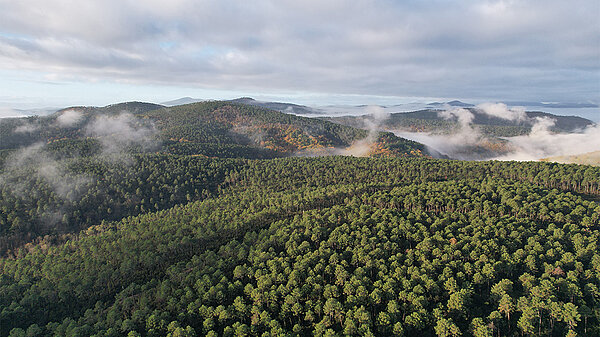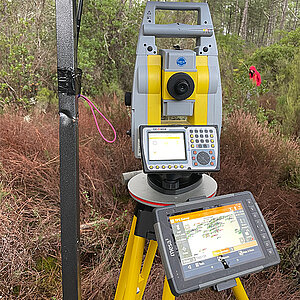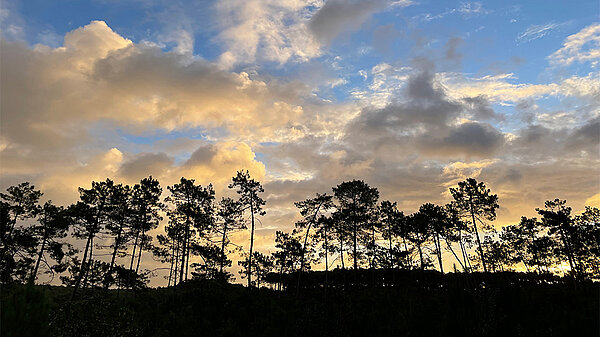What’s that shiny bird?

I, an ecologist/geneticist by profession, cannot say I'd ever expected to be here. Okay, maybe I saw myself exploring forests in the Tuscan hills and on the banks of the Danube, but certainly not with a GNSS rover antenna clutched in my hand, walking in circles while I georeference Populus nigra or Pinus pinaster trees. A telltale buzz catches my attention and I glimpse our unmanned aerial vehicle as it zips overhead, piloted by an unseen but not unheard Mallorcan somewhere out in the bush. Such is the way of working on an international interdisciplinary science project. You'll find yourself in places you never expected, sprinting towards goals you didn’t even know were possible to achieve.
I’m here as part of the Forgenius remote sensing team. In essence, our goal is simple. We're counting the number of seeds (or cones) on each individual tree as a fitness estimate, which we can later associate with that tree's genotypes. In practice, our method also seems simple. We program commercially-available unmanned aerial vehicles (UAVs, or drones) to zoom back and forth above a forest patch, automatically taking photos every two seconds, which we will stitch together into an orthoimage. Later we’ll train machine learning algorithms to recognize and count seeds, and the GNSS data helps us locate individual trees within the orthoimage.

The sleek fancy devices are the obvious stars of this show, and how could they not be? The drone happily chirps as it wakes up, and then literally hums to itself while it springs off the launchpad and dances across the sky. It gathers data without complaint, except when it's hungry for power or when the tree crowns get a bit too close. The GNSS device is more the strong and silent type, but its feats are no less impressive: it can tell you precisely where you are on Earth, with less than a centimeter of error, and it only complains when the trees are blocking all the satellites (so: often). In contrast, we field hands are a bunch of battered and sweaty antiques who complain about everything, including how it seems like our only job is to support the devices, feeding them an endless supply of recharged batteries or flight plan files so they can continue on with their work.
You may have noticed that I said our tasks seem simple. In France, we faced torrential downpours that destroyed our work station’s patio umbrella. In Vienna, an upriver dam released enough water to raise the Danube by a meter and swallow up one of our ground control points, which we use for georeferencing the orthoimage. In Zaragoza, endless sunny days delayed our UAV flights, which are best completed with 100% cloud cover to reduce reflections and contrast in the orthoimage (I know, poor us, too much sun in Spain!). In Tuscany, the strawberry trees were loaded with ripe fruit, which made for delicious snacks, but the shrubs were so thick that we spent an entire morning just getting the GNSS device into position.
Even if we couldn’t laugh about these setbacks (yet), it was easy to overlook them in favor of enjoying Nature’s unexpected gifts. A blood-orange sunrise greeted us in France before the daily rains began. A muster of storks, freshly migrated back from Africa, soared overhead as we worked on Spain’s Ebro River. A black kite circled the drone, even swooping underneath at one point to gift us with an unsolicited selfie. By far our most curious visitors are human: hikers, park rangers, hunters, and parents dropping their kids off at the bus stop all want to know everything about our fancy devices.
Our proverbial glass is half-full: four of the eight inaugural flights have been completed for the Forgenius sites, and we’re back in Germany now to process the data. The Slovenian and French Alps, Scottish Highlands, and a Finnish island are still on our to-do list this year. Weather and field challenges might be impossible to predict, but some things are certain: the [mis]adventures, curiosity, and perseverance will continue. We prevail thanks in huge part to an unseen network of biologists and geographers and professors and park employees and local partners who work behind the scenes to support us, feeding us an endless supply of encouragement and permissions and last-minute solutions to unforeseen problems. Every one of us has to pull our respective strings to get this novel project and shiny bird off the ground, and geez, just look at it fly.
